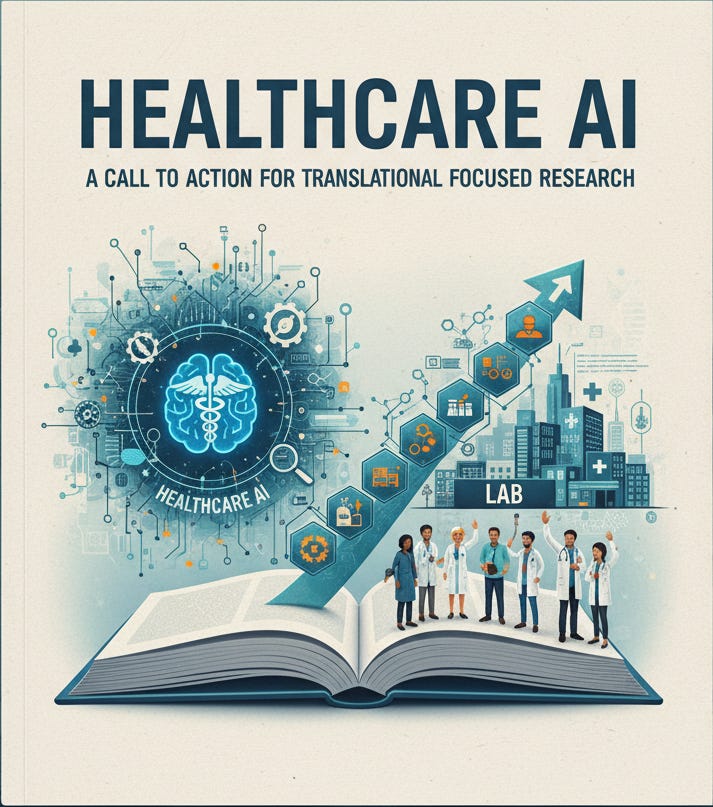I have spent the past decade dedicated to researching the application of artificial intelligence (AI) in healthcare. This has taught me a sobering truth: while AI in healthcare continues to make technical breakthroughs, very little of it has a significant clinical impact (at least relatively small in scale to lead to clinical breakthroughs). Multiple studies have shown that while algorithms often perform well in terms of technical metrics, such as accuracy and precision, they tend to achieve lower results when measured by utility and adoption. Real-world integration is the Achilles’ heel.
To assess this gap, a few years ago, we led the development of the Translational Evaluation of Healthcare AI (TEHAI) framework (to the best of my knowledge, this is the only translational evaluation tool for healthcare AI, whose credibility has been attested by the World Health Organisation and the New Zealand Government). In our review of COVID-19 AI models using the TEHAI framework, only about 15–20% demonstrated adequate translational value, with most models never advancing beyond the proof-of-concept stage. This mirrors findings from other large-scale analyses, which show persistent gaps in workflow integration, external validation, and sustainable clinical deployment.
Why is healthcare different? Unlike sectors such as finance or e-commerce, clinical environments are complex, safety-critical, and highly regulated. Data is fragmented and biased, workflows are deeply human-centric, and organisational readiness for AI is often underestimated. Regulatory frameworks usually lag behind the evolution of machine learning systems, and clinicians are reluctant to adopt tools they distrust or find unhelpful. Even when an algorithm works in one hospital, it may fail in another due to data drift, interoperability gaps, or cultural differences in practice.
Yet this is precisely why we need to invest in translational AI research and infrastructure. The promise of AI to reduce diagnostic delays, optimise care pathways, and personalise treatment cannot be realised if systems stall at the prototype stage. To move forward, we must:
Develop and adopt structured evaluation frameworks. TEHAI type of evaluation frameworks help teams assess capability, utility, and adoption early and iteratively, not just at publication time.
Fund implementation science. Understanding how AI tools fit into real clinical workflows, interact with human decision-making, and maintain performance under change is as important as algorithm design.
Strengthen governance and regulation. Adaptive approval pathways, post-market surveillance, and clear liability frameworks will reduce uncertainty for innovators and adopters.
Build organisational readiness. Healthcare providers require a robust technical infrastructure, MLOps capacity, effective change management, and AI literacy programs tailored for clinicians.
Foster multi-stakeholder collaboration. Translational success requires technologists, clinicians, patients, ethicists, regulators, and policymakers collaborating from concept to deployment.
Figure 1. It is essential to prioritise translational outcomes in the development of healthcare AI.
Healthcare AI adoption is lagging far behind its potential, and this is not a problem that better models alone will solve. Without a deliberate translational mindset, we risk wasting resources on elegant algorithms that ultimately fail to benefit patients. My message to researchers, clinicians, and policymakers is clear: treat translation as a first-class scientific challenge. Prioritise funding and career recognition for those undertaking the challenging, yet essential, work of integration, validation, and governance. Build partnerships that bridge academia, industry, and health systems. Above all, prioritise patient safety, workflow efficiency, and real-world effectiveness in AI innovation. Only then can we close the gap between AI’s promise and its impact in clinical care.
References
Reddy, S., Rogers, W., Makinen, V. P., Coiera, E., Brown, P., Wenzel, M., Weicken, E., Ansari, S., Mathur, P., Casey, A., & Kelly, B. (2021). Evaluation framework to guide implementation of AI systems into healthcare settings. BMJ health & care informatics, 28(1), e100444. https://doi.org/10.1136/bmjhci-2021-100444
Casey, A. E., Ansari, S., Nakisa, B., Kelly, B., Brown, P., Cooper, P., Muhammad, I., Livingstone, S., Reddy, S., & Makinen, V. P. (2023). Application of a Comprehensive Evaluation Framework to COVID-19 Studies: Systematic Review of Translational Aspects of Artificial Intelligence in Health Care. JMIR AI, 2, e42313. https://doi.org/10.2196/42313
Kelly, C. J., Karthikesalingam, A., Suleyman, M., Corrado, G., & King, D. (2019). Key challenges for delivering clinical impact with artificial intelligence. BMC medicine, 17(1), 195. https://doi.org/10.1186/s12916-019-1426-2
Poddar, M., Marwaha, J. S., Yuan, W., Romero-Brufau, S., & Brat, G. A. (2024). An operational guide to translational clinical machine learning in academic medical centers. NPJ digital medicine, 7(1), 129. https://doi.org/10.1038/s41746-024-01094-9
Choudhury, A., & Asan, O. (2020). Role of Artificial Intelligence in Patient Safety Outcomes: Systematic Literature Review. JMIR medical informatics, 8(7), e18599. https://doi.org/10.2196/18599
Boag, W., Hasan, A., Kim, J. Y., Revoir, M., Nichols, M., Ratliff, W., Gao, M., Zilberstein, S., Samad, Z., Hoodbhoy, Z., Ali, M., Khan, N. S., Patel, M., Balu, S., & Sendak, M. (2024). The algorithm journey map: a tangible approach to implementing AI solutions in healthcare. NPJ digital medicine, 7(1), 87. https://doi.org/10.1038/s41746-024-01061-4
Ahmed, M. I., Spooner, B., Isherwood, J., Lane, M., Orrock, E., & Dennison, A. (2023). A Systematic Review of the Barriers to the Implementation of Artificial Intelligence in Healthcare. Cureus, 15(10), e46454. https://doi.org/10.7759/cureus.46454



Excellent points on one of the most under appreciated realities of healthcare AI. Absolutely agree, translation (not modelling) is the real bottleneck for healthcare. And translation isn’t neutral, workflows we redesign and populations we validate in will decide if AI reduces or deepens inequities. I also think we need to treat implementation science and change management as core competencies in health management. Clinician engagement, workflow redesign, regulatory alignment etc. The next frontier isn’t smarter models but rather making adoption safe, equitable and routine.